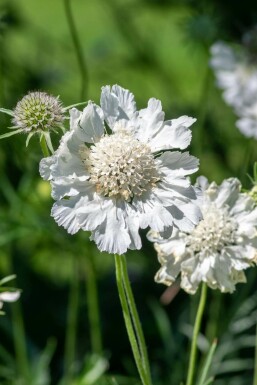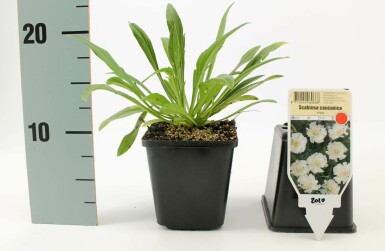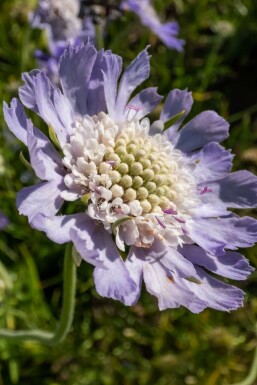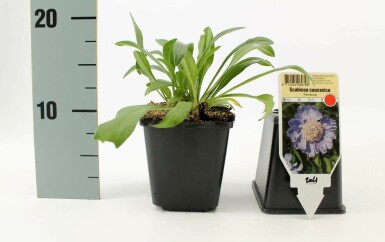

60cm


Updated on 10 September 2025
We regret to inform you that we are currently unable to ship orders to the United Kingdom. We anticipate being able to resume shipments at the beginning of 2026.
Scabiosa offers a stunning display with its long flowering period from summer to autumn. Perfect for borders or rock gardens, it attracts bees and butterflies. Its airy flower structure adds elegance, while being low maintenance and ideal as a cut flower.


60cm




60cm


Scabiosa, known for its vibrant cushion-like flowers, offers a burst of colour from June to October. With its upright growth and pinnate leaves, it transforms any garden space into a lively spot. The flowers, in shades of blue, purple, white, and pink, are perfect for attracting butterflies and bees, making it an excellent choice for a pollinator garden. Curious about how to enhance your borders with these long-blooming beauties? Discover how their nut-shaped seeds can also provide seasonal interest. Suitable for border plants or rock gardens, Scabiosa adds charm and utility. Consider adding this pincushion flower to your collection for a splash of colour and life. Buy Scabiosa UK to enjoy its endless bloom season and delightful pollinator attraction.
Scabiosa, often known as the pincushion flower, is a delightful addition to any garden. This plant, also called Scabiosa caucasica, is cherished for its elegant blooms and long flowering period. As a cottage garden perennial, Scabiosa is a pollinator favourite, attracting bees and butterflies with its rich nectar. Scabiosa belongs to the Caprifoliaceae family and is naturally found across Europe, Asia, and Africa. Despite its exotic origins, it thrives in local gardens, offering a compact habit ideal for borders, group plantings, or planters. The etymology of Scabiosa traces back to the Latin word 'scabies,' reflecting its historic medicinal use. It symbolises loyalty and innocence, making it popular in floral arrangements. As a sun-loving plant, Scabiosa grows either as a perennial or annual, showcasing airy growth and charming flowers that serve as a pollinator magnet. With its versatile uses and appeal, it's not surprising that many choose to buy Scabiosa in the UK, where it continues to enchant gardeners and enhance biodiversity. If looking to create a vibrant and environmentally friendly space, consider adding Scabiosa to the garden, where it shines as a long-blooming pollinator flower.
Scabiosa, known for its long-blooming nature, is a clump-forming plant with tall flower stems. This perennial is favoured in borders and group plantings. The growth form is airy, making it a beautiful addition to any garden. The plant features upright growth and pinnate leaves. Its cushion-like flowers showcase long stamens, coming in colours like lavender blue, purple, pink, white, and cream.
Scabiosa develops from a seed to a mature plant with ease. It thrives in sunny locations, attracting butterflies and bees. From seed to sprout, this plant grows steadily, reaching a mature height between 30 cm and 100 cm. Proper care includes adequate sunlight and well-drained soil, ensuring a lush display from June to October.
The blooming period of Scabiosa spans from early summer to autumn. The timing and longevity of blooms depend on climate and soil conditions. Scabiosa is a pollinator magnet, drawing in insects with its vibrant flowers. Factors like temperature and the plant's age also play a role in its flowering success.
The colour of Scabiosa blooms can vary significantly, influenced by species and soil quality. These flowers are perfect for cut arrangements due to their diversity in colour, adding a splash of elegance to any setting.
Scabiosa (little bluestem) is not particularly known for its fragrance, but contributes to biodiversity with its presence. Its stature and form make it ideal for borders, adding vertical interest to gardens. With a habit that can be described as compact, it fits well in natural gardens and insect corners. Scabiosa is an airy perennial that attracts butterflies.
Scabiosa leaves have an elongated to lanceolate shape with finely serrated edges. They range in colour from grass green to a bluish green, adapting well to different conditions. These leaves remain vibrant during the growing season but may die back in winter in colder climates. In terms of winter hardiness, Scabiosa can withstand temperatures as low as -29°C, making it suitable for USDA zones 5 to 6. Its ability to endure harsh winters depends on the location, soil, and exposure to wind. Some Scabiosa varieties might retain their foliage in milder areas, while others may go dormant and regrow in spring. This characteristic makes them ideal for butterfly-attracting border plantings. Scabiosa's ability to resist heat and drought is notable. Originating from regions with dry climates, their leaves might have a waxy layer which helps in moisture retention. Deep root systems allow these plants to access water from lower soil levels, making them reliable perennials even during dry spells. Safety-wise, Scabiosa is not toxic to humans or pets, making it perfect for gardens frequented by children and pets. It is safe to cultivate without concern for harmful effects. In terms of biodiversity, Scabiosa is a magnet for butterflies, contributing to the garden's ecological health. Their long-blooming nature from June to October supports pollinators extensively. Incorporating Scabiosa in a garden can enhance the natural appearance and provide a haven for pollinators, ensuring a balanced ecosystem.
Scabiosa, often known as the pincushion flower, brings charm and life to any garden. The long blooming period of Scabiosa makes it a favourite for summer and autumn displays. This plant is highly regarded for attracting bees and butterflies, making it an excellent choice for a bee garden. Here are some ways to incorporate Scabiosa into your garden:
Scabiosa adds beauty and charm to any garden. Combining Scabiosa with other plant types can enhance the garden's diversity and appeal. Scabiosa thrives alongside plants like Echinacea, Verbena bonariensis, and Achillea. These combinations provide both colour and texture throughout the summer and autumn seasons. Echinacea's bold flowers contrast beautifully with Scabiosa's intricate blooms, while Verbena bonariensis adds height and elegance to borders. Achillea's feathery foliage complements the delicate petals of Scabiosa, creating a harmonious display. Salvia and Gaura also make excellent partners, offering long-lasting blooms and attracting beneficial pollinators. Scabiosa is a butterfly magnet and decorates the garden as a classic bee plant. These plant combinations not only bring visual interest but also support biodiversity in the garden. Planting Scabiosa with these companions ensures a lively and flourishing garden space. The mix attracts butterflies and provides a delightful display from summer into autumn. Adding Scabiosa to your borders will create a dynamic and diverse planting scheme that continually draws the eye and supports local wildlife.
Scabiosa thrives in sunny spots with at least six hours of sunlight each day. Adequate light is crucial for its long-blooming feature. The plant prefers well-drained, calcareous soil that is moderately fertile. This ensures strong growth and vibrant blooms. Scabiosa is known for its airy structure, making it a perfect choice for garden borders and attracting pollinators. Wind can affect Scabiosa, so placing it near a fence or hedge can help. This provides a barrier against strong gusts, allowing the plant to focus on blooming. Maintaining soil moisture is key. Although it is drought-tolerant, regular watering during dry spells keeps it healthy. Ensure the soil is well-drained to prevent waterlogging, which can harm the roots. For optimal growth, the soil's pH should be neutral to slightly alkaline. Testing the soil and adjusting with lime if necessary will promote flourishing blooms. Regular feeding with balanced fertiliser supports the plant's needs and enhances its role as a pollinator favourite. Whether planting a cottage garden perennial or a pincushion flower, considering these factors will yield a beautiful and resilient Scabiosa display.
Scabiosa is best planted in spring (April–May) or late summer (September). Planted in pots, it suits year-round planting except during frost. Those with roots or soil balls should be planted mainly in spring or autumn. The plant spacing depends on the variety, size at planting, and growth speed. Scabiosa thrives in calcareous, well-drained, and moderately fertile soil, receiving full sun for at least six hours daily. For poor soils, adding compost helps. Ideal for prairie gardens or borders, it has an airy growth habit and blooms long, tolerating drought well. To plant Scabiosa, prepare the soil well, preferably with Heijnen planting soil. Follow with regular watering and fertilising after planting. The plant attracts butterflies and has benefits for a cottage garden. As part of the border, Scabiosa fulfils its role beautifully, standing out with its unique pincushion flowers and is a favourite among pollinators. Little bluestem fits into this environment, adding texture and contrast with its airy form. Scabiosa is a reliable addition to any garden.
Scabiosa, also known for its long-blooming and airy growth, thrives best with consistent care. This cottage garden perennial attracts a variety of pollinators, making it a rich nectar source. For those wondering, will Scabiosa flower again after deadheading, proper maintenance ensures a prolonged blooming period from June to October.
The Scabiosa's role as a pollinator favourite enhances any garden with its vibrant blooms and ecological benefits. For those looking to extend their plant collection, don't forget to buy little bluestem, another attractive addition to group planting schemes.
Scabiosa brings a beautiful display to summer gardens with its unique flowers. The blooms come in shades of lavender blue, purple, pink, white, and cream. These colourful flowers are not only attractive but also draw in butterflies, making them a fantastic addition to any garden. The plant has an airy growth form, with tall flower stems that sway gently in the breeze. This movement adds another layer of interest to the garden. The leaves are grass green to bluish green, adding a soft texture to the overall appearance. Scabiosa is an airy garden plant loved by butterflies. It offers structure during the growing season and is known for its long flowering period, which can enhance the garden's beauty from summer into autumn. As a perennial, Scabiosa is low maintenance and enjoys full sun, making it a practical choice for many gardeners. It serves well in borders, rock gardens, and bee gardens, providing both seasonal interest and ecological benefits. Its ability to attract butterflies and bees makes it a valuable plant for those looking to support local wildlife and enjoy the natural allure it offers. This pincushion flower is not only a pollinator favourite but also a reliable, long-blooming feature in any garden.
Scabiosa is a popular choice for garden enthusiasts due to its unique charm. Known for its distinct pincushion-like flowers, it offers both aesthetic and ecological benefits.
Advantages:
Disadvantages:
Proper soil preparation and placement, along with good care and timely fertilisation, can reduce the risk of pests and diseases. Always ensure plants are well-cared for to achieve the best growth and flowering results.
Scabiosa is a fantastic addition to any garden, blooming from June to October. Its long flowering period makes it a favourite among gardeners. Attract bees and butterflies with Scabiosa's airy flower structure, perfect for borders or a bee garden. This perennial requires low maintenance, and its compact habit fits well in any garden space. Scabiosa also makes a great choice for cut flowers, adding elegance to arrangements.
For those interested in pollinator magnets, Scabiosa is ideal. It pairs beautifully with little bluestem, adding texture to summer and autumn displays. The ease of maintenance makes it suitable for gardeners of all levels. Buy Scabiosa UK from Heijnen to enjoy its beautiful, long-blooming flowers.
Buy the elegant Scabiosa (Pincushion flower) from Heijnen and attract butterflies with its romantic blooms in soft hues.
We would like to provide some tips on how to plant and care for a Scabiosa. By following these tips, you can be sure to enjoy your Scabiosa for a long time.
Scabiosa thrives best in a sunny spot with well-drained, moderately fertile soil. It's important to plant in a location with at least 6 hours of sunlight each day. The soil should be calcareous and free-draining to prevent waterlogging. These conditions lead to healthier growth and a longer blooming period from summer to autumn. The vibrant flowers attract pollinators, making scabiosa ideal for a bee garden or natural planting area. The plant adapts well to dry conditions, enhancing its resilience. In the garden, it suits borders, group plantings, and pots. Opt for a spring or late summer planting to ensure optimal establishment. The right spot encourages not just rich blooms, but also a robust and beautiful plant. Proper placement is key to achieving the best growth and flower display for scabiosa.
Preparing the soil is crucial when planting Scabiosa to ensure healthy growth. Tilling the ground improves water drainage and nutrient availability. Mix compost into the soil for better water retention and aeration. Proper soil preparation is important before planting Scabiosa or any other plant because it supports root establishment and nutrient uptake. Pot-grown Scabiosa can be planted any time of the year, except during frost periods. Always keep the jute sack around the root ball of balled plants, and plant these in spring or autumn. After planting, give them regular watering until their roots are established. The size of the Scabiosa plants determines how many can be planted per square metre. Consider spacing for maximum growth and visual impact in the garden. Meanwhile, little bluestem can add contrasting texture and height, thriving in similar sunny conditions.
Fertilising Scabiosa is vital for healthy growth and vibrant blooms. Regular feeding ensures robust plants and enhances their natural vitality. It is beneficial to use organic or organic-mineral fertiliser from Heijnen for Scabiosa. This choice promotes strong growth and vibrant flowering, maintaining plant health. Apply fertiliser twice a year: once in spring and again in summer, ensuring continuous nourishment. The amount depends on plant size. Larger plants require more. Fertiliser application becomes effective when watered in. In dry periods, ensure thorough watering to release nutrients into the soil, allowing roots to absorb them efficiently. Little bluestem and other plants benefit too from these practices, ensuring a lively and thriving garden environment.
Scabiosa benefits from regular pruning to maintain a healthy appearance. When trimmed correctly, it encourages more blooms and a fuller growth. It is ideal to prune after the flowers have faded. This not only removes dead flowers but also prepares the plant for a longer period of flowering. Using sharp secateurs ensures clean cuts, which is crucial for plant health. Investing in good tools can make the process smoother and prevent damage to the Scabiosa. Pruning in March is recommended for light trimming, helping keep the growth tidy. Every three years, dividing the Scabiosa can also be beneficial. A well-maintained Scabiosa offers beautiful blooms and enhances any garden setting. Applying these techniques will surely make Scabiosa a highlight in any outdoor space.
Scabiosa requires moderate water. Some species can handle drought better, like alpine types, but generally, regular watering during hot summers helps maintain blooms. Newly planted Scabiosa needs timely watering to establish roots. Once established, water is only necessary during prolonged dry spells. Giving plenty of water at once is better than daily small amounts. It’s best to water in the early morning or late afternoon to minimise evaporation. Checking the soil helps determine if water is needed. Excess water should always drain away, whether in the ground, pots, or planters. Drip lines are effective for established plants, but young ones also benefit from additional watering. For little bluestem, ensure adequate drainage and appropriate watering for healthy growth.
Scabiosa, a delightful addition to any garden, enchants with its flat or globular blooms. Known for its long flowering season, this plant attracts bees and butterflies, making it a favourite among pollinators. Its airy flower structure adds a natural look to gardens. Scabiosa’s non-toxic nature ensures safety for children and pets. For those looking to diversify their garden, pairing Scabiosa with little bluestem can create a visually appealing mix. Enjoy the beauty and ecological benefits it brings.
Dividing Scabiosa helps keep the plant healthy and promotes growth. This process involves carefully digging up the plant and removing old parts. It is best done every three to four years. After division, replant young sections back into the garden. Divide either in spring or autumn, but the preference is autumn. Use a sharp spade or garden fork for the task. This not only rejuvenates the Scabiosa but also encourages more blooms. Dividing also allows more space for little bluestem to thrive alongside. Always ensure plants are well-watered before and after dividing to reduce stress. This practice supports a vibrant garden with healthier plants.
Little bluestem is a delightful plant that stands upright with pinnate leaves and cushion-like flowers. Blooming from June to October, it attracts bees and butterflies, serving as a rich nectar source. The airy flower structure and long flowering period make it a perfect addition to borders or rock gardens. Buy Scabiosa (little bluestem) from Heijnen to enjoy its charming lavender to cream blooms and bring life to your garden.
